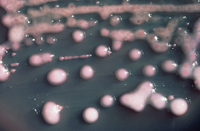
Francisella philomiragia: Think of Chronic Granulomatous Disease
Sign Up to like & getrecommendations! Published in 2018 at "Journal of Clinical Immunology"
DOI: 10.1007/s10875-018-0498-7
Abstract: A 20-year-old man was referred to our department with fever (about 38 °C), odynophagia, and dry cough for 2 weeks. He has a history of chronic granulomatous disease (CGD) linked X, diagnosed 18 months of… read more here.
Keywords: granulomatous disease; francisella; francisella philomiragia; chronic granulomatous ... See more keywords

Tick-Bacteria Mutualism Depends on B Vitamin Synthesis Pathways
Sign Up to like & getrecommendations! Published in 2018 at "Current Biology"
DOI: 10.1016/j.cub.2018.04.038
Abstract: Mutualistic interactions with microbes have facilitated the radiation of major eukaryotic lineages [1, 2]. Microbes can notably provide biochemical abilities, allowing eukaryotes to adapt to novel habitats or to specialize on particular feeding niches [2-4]. To… read more here.
Keywords: synthesis pathways; francisella; mutualism; vitamin synthesis ... See more keywords

Challenges of Francisella classification exemplified by an atypical clinical isolate.
Sign Up to like & getrecommendations! Published in 2018 at "Diagnostic microbiology and infectious disease"
DOI: 10.1016/j.diagmicrobio.2017.11.023
Abstract: The accumulation of sequenced Francisella strains has made it increasingly apparent that the 16S rRNA gene alone is not enough to stratify the Francisella genus into precise and clinically useful classifications. Continued whole-genome sequencing of… read more here.
Keywords: francisella; clinical isolate; challenges francisella; francisella classification ... See more keywords

Intracellular Experimental Evolution of Francisella tularensis Subsp. holarctica Live Vaccine Strain (LVS) to Antimicrobial Resistance.
Sign Up to like & getrecommendations! Published in 2023 at "ACS infectious diseases"
DOI: 10.1021/acsinfecdis.2c00483
Abstract: In vitro experimental evolution has complemented clinical studies as an excellent tool to identify genetic changes responsible for the de novo evolution of antimicrobial resistance. However, the in vivo context for adaptation contributes to the… read more here.
Keywords: francisella; experimental evolution; resistance; antimicrobial resistance ... See more keywords

The metabolic enzyme fructose-1,6-bisphosphate aldolase acts as a transcriptional regulator in pathogenic Francisella
Sign Up to like & getrecommendations! Published in 2017 at "Nature Communications"
DOI: 10.1038/s41467-017-00889-7
Abstract: The enzyme fructose-bisphosphate aldolase occupies a central position in glycolysis and gluconeogenesis pathways. Beyond its housekeeping role in metabolism, fructose-bisphosphate aldolase has been involved in additional functions and is considered as a potential target for… read more here.
Keywords: francisella; fructose bisphosphate; bisphosphate aldolase; enzyme fructose ... See more keywords

Complete genome sequence of the emerging pathogen Cysteiniphilum spp. and comparative genomic analysis with genus Francisella: Insights into its genetic diversity and potential virulence traits
Sign Up to like & getrecommendations! Published in 2023 at "Virulence"
DOI: 10.1080/21505594.2023.2214416
Abstract: ABSTRACT Cysteiniphilum is a newly discovered genus in 2017 and is phylogenetically closely related to highly pathogenic Francisella tularensis. Recently, it has become an emerging pathogen in humans. However, the complete genome sequence of genus… read more here.
Keywords: francisella; cysteiniphilum; diversity; complete genome ... See more keywords

Francisella salimarina sp. nov., isolated from coastal seawater.
Sign Up to like & getrecommendations! Published in 2020 at "International journal of systematic and evolutionary microbiology"
DOI: 10.1099/ijsem.0.004164
Abstract: Four strains (SYSU SYW-1T, SYW-2, SYW-3 and XLW-1) were isolated from seawater near the shore in Guangdong Province, China. Cells were Gram-stain-negative, aerobic, non-motile and non-spore-forming. Growth was observed at a temperature range of 16-40 °C… read more here.
Keywords: seawater; salimarina nov; francisella salimarina; 16s rrna ... See more keywords

Genomic characterization of Francisella tularensis and other diverse Francisella species from complex samples
Sign Up to like & getrecommendations! Published in 2022 at "PLoS ONE"
DOI: 10.1101/2022.08.07.503100
Abstract: Francisella tularensis, the bacterium that causes the zoonosis tularemia, and its genetic near neighbor species, can be difficult or impossible to cultivate from complex samples. Thus, there is a lack of genomic information for these… read more here.
Keywords: dna; francisella; diverse; complex samples ... See more keywords

Subversion of innate immune responses by Francisella involves the disruption of TRAF3 and TRAF6 signalling complexes
Sign Up to like & getrecommendations! Published in 2017 at "Cellular Microbiology"
DOI: 10.1111/cmi.12769
Abstract: The success of pathogens depends on their ability to circumvent immune defences. Francisella tularensis is one of the most infectious bacteria known. The remarkable virulence of Francisella is believed to be due to its capacity… read more here.
Keywords: subversion innate; immune responses; responses francisella; francisella ... See more keywords

Characterization of a Unique Outer Membrane Protein Required for Oxidative Stress Resistance and Virulence of Francisella tularensis
Sign Up to like & getrecommendations! Published in 2018 at "Journal of Bacteriology"
DOI: 10.1128/jb.00693-17
Abstract: ABSTRACT Francisella tularensis, the causative agent of tularemia, lacks typical bacterial virulence factors and toxins but still exhibits extreme virulence. The bacterial multidrug efflux systems consist of an inner membrane, a transmembrane membrane fusion protein,… read more here.
Keywords: protein; virulence; silc; francisella ... See more keywords

Differentiation of Francisella tularensis Subspecies and Subtypes
Sign Up to like & getrecommendations! Published in 2020 at "Journal of Clinical Microbiology"
DOI: 10.1128/jcm.01495-19
Abstract: The highly infectious and zoonotic pathogen Francisella tularensis is the etiologic agent of tularemia, a potentially fatal disease if untreated. Despite the high average nucleotide identity, which is >99.2% for the virulent subspecies and >98%… read more here.
Keywords: tularensis subspecies; francisella tularensis; tularensis; tularensis subsp ... See more keywords